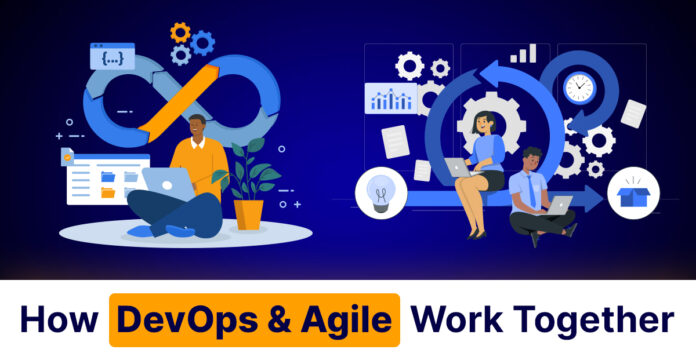Businesses worldwide are joining the gold rush and digital transformation to deliver ultimate customer satisfaction, seize a competitive edge, and grow profits. As technological innovations soon become a passive fad, businesses need to build software at an accelerated pace while maintaining quality. Well, it’s tricky.
Thankfully, fast-paced technological development has enabled faster, bug-free deliveries with DevOps and Agile technologies. The two technologies are different, but their primary functions remain the same. DevOps helps reduce the number of steps in software development, and Agile expedites project delivery speed with seamless project management.
When DevOps and Agile are used together as agile DevOps, both technologies’ shortcomings are overcome, resulting in faster delivery and better customer satisfaction. This blog will walk you through an overview of DevOps and Agile, ways to integrate them during software development, and the benefits your business will reap after DevOps Agile integration. Let’s explore!
What is DevOps?
DevOps is a software development practice that brings together people, processes, and technology for continuous software deliveries. With constant feedback, the software is built, deployed, and integrated continuously because software development and IT operations teams work simultaneously. The stellar communication and high collaboration result in accelerated development or update. This approach encourages continuous development, testing, deployment, and integration. Hire DevOps developers to enjoy automation and collaboration benefits in software development.
What is Agile?
Agile development involves cross-functional teams working together to determine project requirements and appropriate solutions. Agile focuses more on people than processes and tools, resulting in high customer value. The approach is prone to adaptive planning, changes in requirements, continuous improvements, and flexible responses to accommodate upcoming changes, ensuring customers’ needs are always met.
What is DevOps agile?
DevOps and agile development practices differ in process scheduling, but they are made to work in tandem. As agile support adaptability in requirement changes and DevOps supports continuous integration deployment, faster development and deployment goals are achieved along with high customer value. Also, continuous iterations based on feedback become plain sailing. Despite these similarities, businesses should carefully select and integrate resources to reduce friction and conflicts among different teams. Hire DevOps developers to enjoy automation and collaboration benefits in software development.
How to integrate DevOps and Agile?
DevOps and Agile help businesses roll out digital transformation with faster deliveries and excellent customer experience. Effective results are achieved with DevOps and Agile when they are integrated following appropriate processes. Here are the steps to consider for DevOps agile integration.
- Identify the latest situation: Without assessing the businesses’ current state, it’s impossible to create a plan for digital transformation. Before integration, businesses should check if the workspace culture is ready to adapt to the change, if leaders are prepared to take on the responsibilities, if the existing system is compatible with the new integration, and whether IT services enable them.
- Go ahead MVP way: Making digital changes across the board in a single go- is not a good decision because employees or people may not support the same immediately. It’s better to transform the business digitally with baby steps that help check whether it seamlessly accommodates the changes. It also reveals the roadblocks that may become a part of the digital journey.
- Identify and address the challenges: Automation is vital in making processes and operations digital at an accelerated pace and reducing errors. However, individually identifying the developmental and deployment challenges is essential to ensure the best practices and principles are followed.
- Enable the cultural change: The primary role of both technologies- DevOps and Agile are the same, but they behave like different cultures. Business leaders need to work intelligently to support cultural change, including encouraging employees to understand the importance of change and get accustomed to this change.
- Optimize it regularly: You will always find room for improvement for every solution. In the competitive age, continuously optimizing software to align with changing market trends, evolving customer preferences, and technological advancements is necessary.
Seven advantages of DevOps and Agile integration with business software
Integrating agile and DevOps brings a range of benefits to businesses that converge on a common objective, adding value to the customers with faster deliveries. Here are the additional benefits that the unification of Agile and DevOps brings to the table.
- Faster time-to-market
DevOps ensures a continuous delivery pipeline through automated testing, integration, and deployment without human intervention, resulting in expedited deliveries. This approach enables quick corrections with faster feedback.
- Reduced cost
Automation is the lifeblood of agile DevOps; it eliminates repetitive tasks and chances of errors, diminishes manual labor needs, and prevents costly fixes at a later stage.
- Improved collaboration
DevOps agile helps bridge the gap between multiple departments (development and operation) and lets the cross-functional teams (developer, designer, tester, and business stakeholders) work together. It helps teamwork in close coordination, facilitating improved communication and enhanced productivity.
- Increased efficiency
CI/CD pipelines improve software development efficiency with manual process automation and expedited software releases. DevOps tools (Jenkins and Docker) and agile tools (Jira and Trello) lend a hand in improving development efficacy.
- Higher customer satisfaction
DevOps and agile aimed to prioritize customer needs and meet them with continuous improvements. When this customer-centric approach becomes the core for decision-making and building or enhancing products, customers get satisfied with the high-quality, customer-focused solution.
- Drive innovation
Iterative development in short cycles creates a ground for innovation. Faster feedback loops, earlier identification of errors, and team adaptability in plan changes based on evolving priorities help innovate software, enabling businesses to keep up with the competition.
Conclusion
A hybrid approach is warmly embraced to bring a paradigm shift across the board. The fusion of DevOps and Agile is set to bring a massive transition with automation, continuous deployment, and quick deliveries. However, harnessing the full potential of the combination of two technologies requires businesses to make fundamental changes in process and culture. So, experiment with DevOps and agile combination to experience the significant difference.






